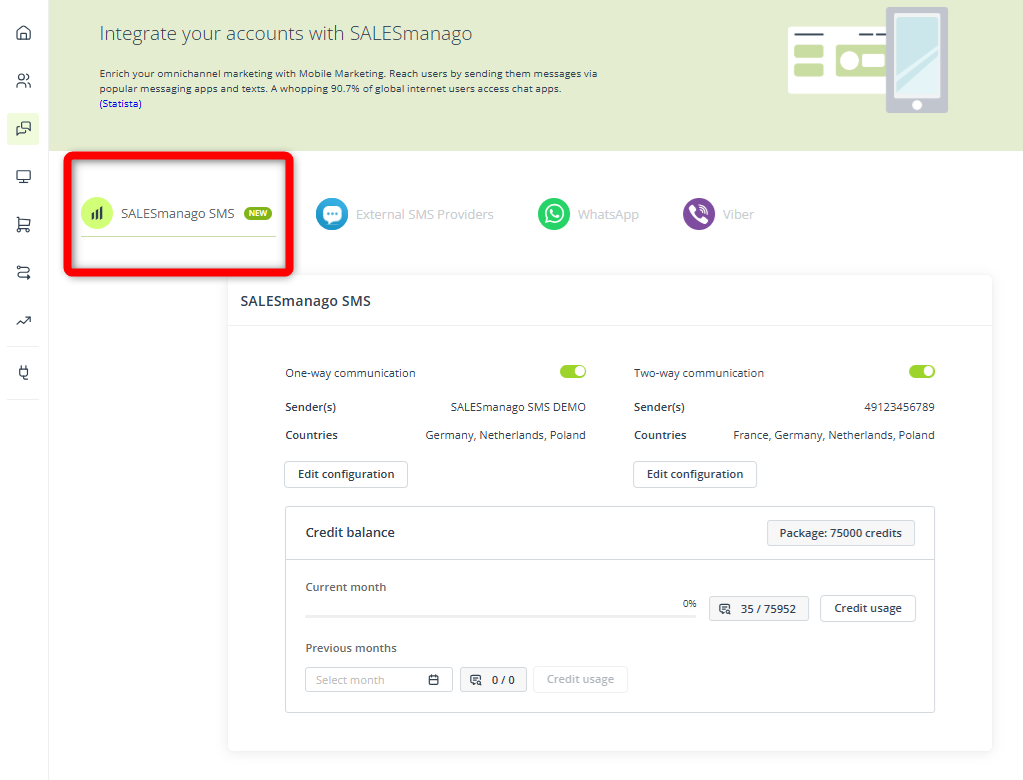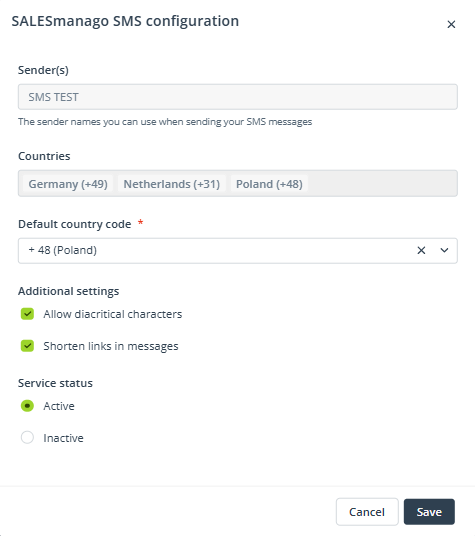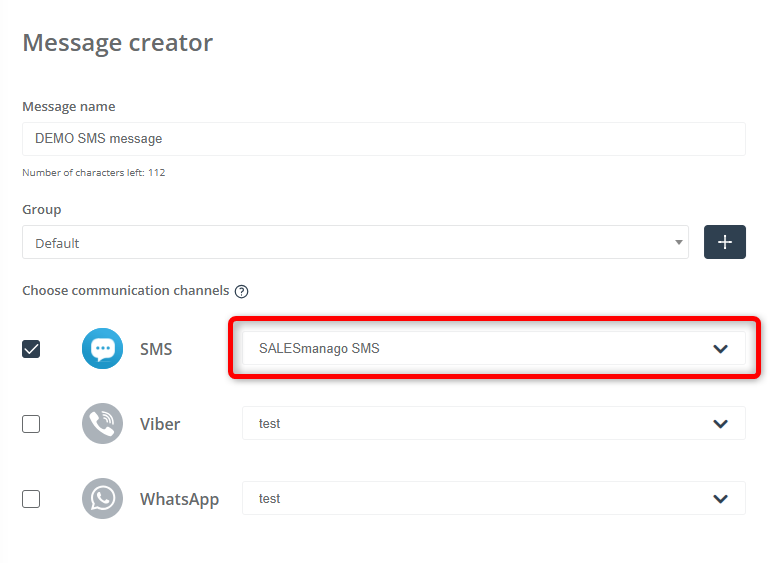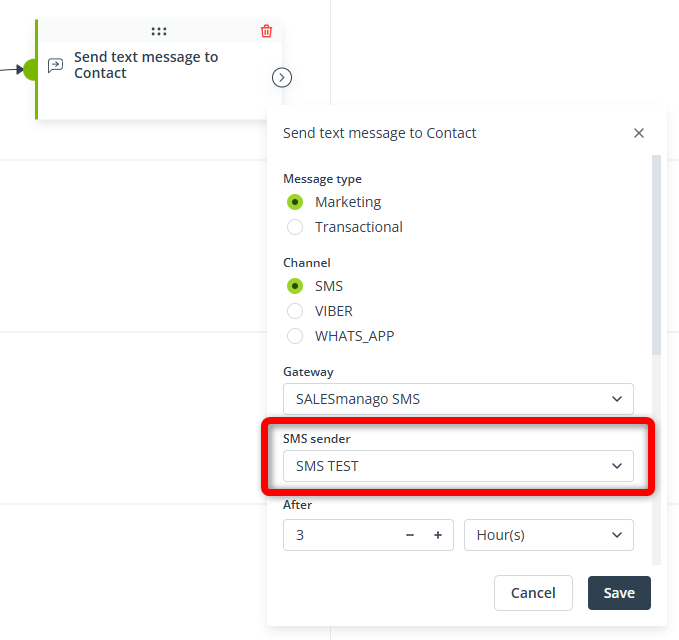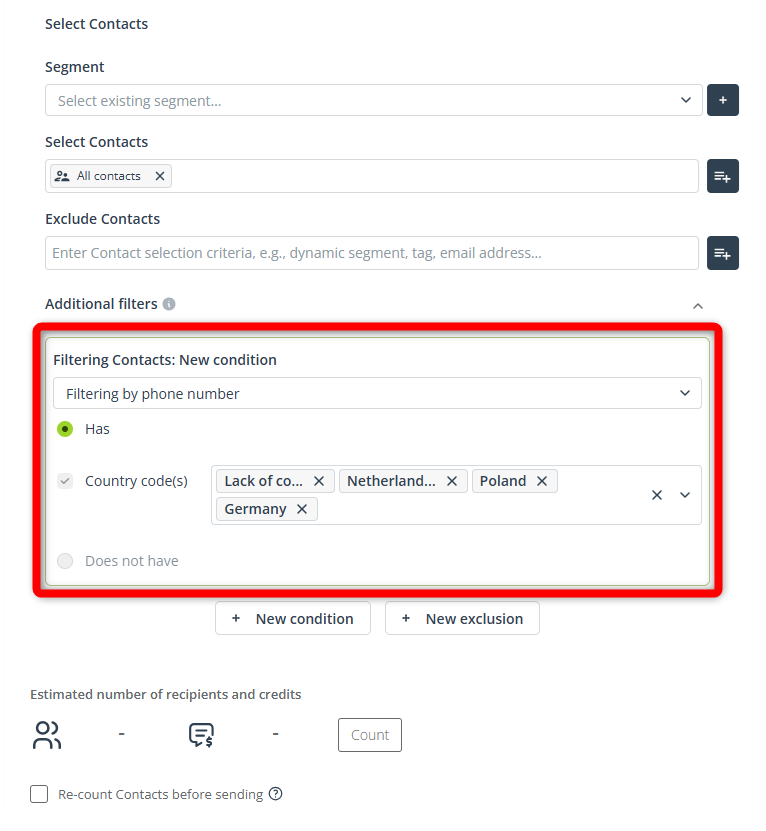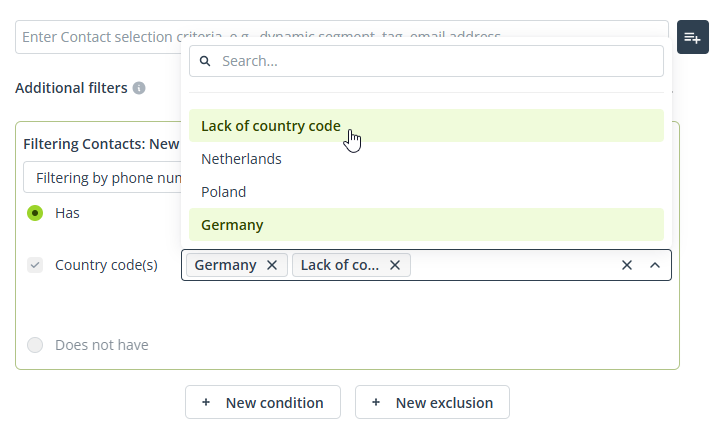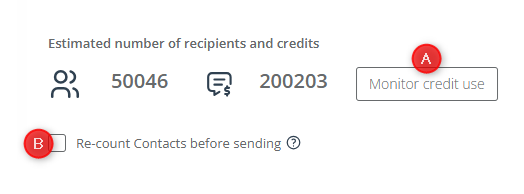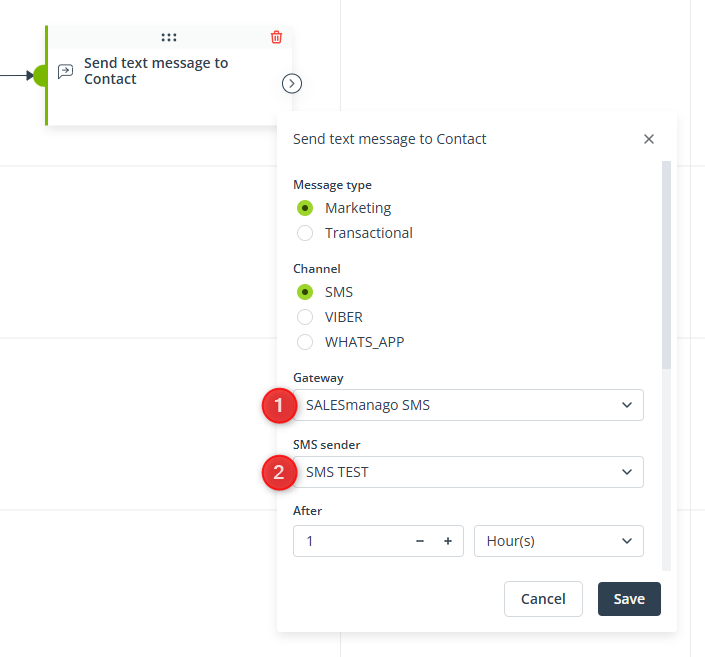SALESmanago SMS is a text message delivery service provided directly by SALESmanago. Instead of – or in addition to – integrating with an external SMS gateway, you can activate this service on your account to enjoy competitive SMS sending rates and centralize your marketing operations even more.
If you use SALESmanago SMS, you can enable two-way SMS communication on your account and enable your recipients to respond to your text messages.
This article provides all the essential information about SALESmanago SMS, including the billing method and practical instructions.
Contents
- Getting started
- SALESmanago SMS in practice
- Credits
- Country codes
- Selecting recipients for mass campaigns
- Text messages sent via Workflows
- Frequently Asked Questions (FAQ)
1. Getting started
With SALESmanago SMS, you can communicate with your Contacts at preferential rates, without having to integrate any external SMS gateways with the SALESmanago platform.
The service is settled based on credits. You can think of them as a form of currency or payment units. When requesting activation, you specify the monthly pool of credits you expect to spend. Each text message sent via SALESmanago SMS consumes a certain number of credits, depending on its length, encoding (use of diacritics or special characters), and destination country. Before sending a mass campaign, you can look up the estimated cost.
NOTE: The sending cost (number of credits per message) may vary depending on the destination country.
To activate SALESmanago SMS on your account, please contact your Customer Success Manager. You will be informed about the current pricing and asked to provide the following details:
- A list of countries to which you intend to send SMS messages. If a country is not in the list, no message can be sent from your account to that country.
- One or more sender names that will be displayed in the recipient’s inbox (for one-way communication).
IMPORTANT: In one-way communication, the recipient will see a name (often referred to as “sender ID” in the telecom industry) as the sender.
In two-way communication, to make replying possible, the recipient will see a phone number assigned by SALESmanago SMS. - The default country code to be added to phone numbers that do not include one.
- Whether you would like to activate two-way SMS communication on your account—to enable your Contacts to respond to your messages.
The default country code can be edited in the SALESmanago SMS settings. To edit the list of countries or sender names, please contact your Customer Success Manager.
Detailed instructions and explanations on how to use SALESmanago SMS in practice are provided further in this article.
2. SALESmanago SMS in practice
When SALESmanago SMS is active on your account, you can see a dedicated tab for this service in Menu → Channels → Mobile Marketing → Integrations.
Here, you can:
- Activate or deactivate the service.
NOTE: Deactivating the service using the dedicated switch does not terminate the service (the annex to your agreement will still remain in effect). You may choose to deactivate SALESmanago SMS, for example, if you are low on credits and want to avoid overspending.
- View the list of available senders (sender names for one-way communication, and sender phone numbers for two-way communication).
- View the list of countries to which you can send messages using this service. If a country is not in the list, it is not possible to send a message there.
- Edit the configuration. While the lists of senders and countries are not editable (to request any changes, contact your Customer Success Manager), you can edit the default country code and decide whether to enable diacritical characters and link shortening in your messages.
The default country code is the prefix that will be added to those recipient phone numbers that have no country code. For detailed explanations, see Sections 4–6 below.
Diacritical characters are letters or symbols that include marks (diacritics) indicating a different pronunciation, tone, or meaning, for example: á, é, í, ó, ú, ś, ć, ż, ñ, ç, ä, ö, ü, ø, etc. Diacritical characters reduce your character limit and may increase message cost (because messages may be split into multiple parts).
Shortened links enable the SALESmanago system to track clicks in text messages. They are also more aesthetic than full-length links. Therefore, we recommend enabling this option.
You can also view the size of your current credit package, credit usage in the current month, and credit usage in previous months. For more information on credits, see Section 3 below.
You can use SALESmanago SMS in both mass campaigns and Workflows.
Read about the Workflow Action: Send text message >>
To use the service, simply select “SALESmanago SMS” from the list of available providers.
NOTE: If you want recipients to be able to respond to your text messages, you need to have two-way SMS communication enabled on your account.
If it is enabled, select “SALESmanago 2-Way SMS” from the list of providers.
When sending a mass campaign or configuring an Automation Process, you need to select a sender from the list of your existing senders:
To add a new sender, or to edit or remove an existing one, please contact your Customer Success Manager.
IMPORTANT: In one-way communication, the recipient will see a name (often referred to as “sender ID” in the telecom industry) as the sender.
In two-way communication, to make replying possible, the recipient will see a phone number assigned by SALESmanago SMS.
When configuring a mass campaign, after defining the list of recipients using Contact selectors and filters, you can click Count to view the estimated number of credits that may be consumed by this campaign.
NOTE: The estimated credit cost is provided only for mass campaigns (not for Automation Processes).
For more information on credits, see Section 3 below.
3. Credits
The cost of text messages sent via SALESmanago SMS is calculated based on credits. Each SMS consumes a certain number of credits, depending on the message length and the destination country.
When requesting the activation of SALESmanago SMS on your account, you can choose from available credit packages—a monthly pool of credits you expect to spend. While the number of credits in your package is added to your balance every month, credits are settled on a quarterly basis.
The first quarter begins on the date of activation and includes the current month plus the following two months.
EXAMPLE: SALESmanago SMS is activated on your account on May 25. The first quarter includes May, June, and July.
Quarterly settlement means that any non-used or overspent credits are carried over to the following months within the same quarter. In other words, the credit pools for the three months of a quarter are combined and can be freely disposed of throughout that quarter.
EXAMPLE: You have a monthly package of 10,000 credits, which gives 30,000 credits per quarter. In a quarter including May, June, and July, you spend:
- 9,500 credits in May
- 12,000 credits in June
- 4,000 credits in July
The total usage in this quarter is 25,500. Since this does not exceed 30,000 credits, no additional costs are incurred—even though you exceeded the monthly package in June.
Credits non-used or overspent in a previous quarter are not carried over to the next quarter. Any overspent credits are calculated at the end of each quarter and must be paid for additionally.
EXAMPLE 1: In the example above, 4,500 credits were not used during the May-July quarter. These credits will not be added to the 30,000 credits you can spend in the next quarter (August–October).
EXAMPLE 2: Your monthly credit package is 50,000 credits, giving you 150,000 credits per quarter. In a quarter covering January, February, and March, you spend 167,000 credits. The quarterly pool was exceeded by 17,000 credits, which must be paid for additionally.
Each time before you send or schedule a mass campaign, after selecting the recipients, you can click Count to check the estimated number of credits likely to be spent on this campaign.
Additionally, a side panel will open, showing the estimated cost of this specific campaign and any other campaigns scheduled for the same month.
IMPORTANT: The figures shown on the sending screen are only estimates. The actual number of credits used may be different due to the following factors:
- Message length: If the message contains dynamic elements such as placeholders, its final length may differ from the estimate. Longer messages may be split into multiple parts, each counting as a “message”.
EXAMPLE: You create the following message:
The number of characters is 160, which is the limit for a single message. However, the placeholder in the message will be replaced with the Contact’s first name, which will affect the actual character count. For longer names, such as “Christopher”, the message may exceed 160 characters. In that case, the message will be split into two parts, and its cost will double.
- List of recipients: If the Mobile Marketing status changes for some Contacts, or if a segment used to define the recipient group is modified before the SMS is actually sent, the number of recipients will change accordingly.
- Invalid phone numbers: Some phone numbers in your database may be incorrect.
- Lack of country code: Some phone numbers in your database may have no country code and may be incompatible with the default country code.
4. Country codes
Like most SMS service providers, SALESmanago SMS requires that recipient phone numbers be preceded by a country code, accompanied by the plus sign (+) or two zeros (00).
Country codes enable the determination of the destination country, and thus—the cost involved in sending text messages.
As messages cannot be sent to phone numbers without a country code, SALESmanago adds the default country code to such numbers. You can define your default country code in the SALESmanago SMS settings (see Section 2 above).
When creating a mass campaign, you can decide whether you want to apply the default country code or not (by using a dedicated filtering option—see Section 5 below).
In Automation Processes, SALESmanago always adds the default country code to phone numbers that do not include one. However, the message is sent only if the default country code matches the actual country of the Contact’s phone number.
5. Selecting recipients for mass campaigns
SALESmanago offers a dedicated Contact filter (condition) for SALESmanago SMS.
This condition is applied automatically when SALESmanago SMS is selected as the messaging service provider. It gives you full control over the destination countries—you can easily include or exclude them from the list.
NOTE: Only countries that are enabled on your account (listed in Menu → Channels → Mobile Marketing → Integrations → SALESmanago SMS tab) can be selected in this condition.
The campaign will only be sent to Contacts whose phone numbers are preceded by the selected country codes. You can also try to reach Contacts who have no country code in their phone numbers—by adding the default country code to those numbers. To do this, include the Lack of country code option in the list:
If the default country code matches the actual country code of a phone number, that Contact will also receive this message.
After selecting your intended audience, make sure to click Count to view the estimated number of recipients and the estimated cost (number of credits that are likely to be spent on this campaign).
More detailed cost analytics will be provided in a right-hand panel. After closing that panel, you can always open it by clicking Monitor credit use [A].
By default, the list of recipients is established the moment you click Send. However, when scheduling a campaign for a later date and time, you may want to ensure that the list is as up to date as possible at the time of sending. In this case, enable the option: Re-count Contacts before sending [B].
When option [B] is enabled, your Contact data is re-analyzed shortly before the campaign is actually sent, in order to establish the final list of recipients. Note that the number of recipients—and therefore the number of required credits—may change significantly in the meantime (and cannot be checked on an ongoing basis).
6. Text messages sent via Workflows
To include SMS messages in a Workflow campaign, use the Action: Send text message to Contact.
To use the SALESmanago SMS service, in field [1], select:
- SALESmanago SMS—for one-way communication.
- SALESmanago 2-Way SMS—if you want to enable Contacts to reply to your message.
Make sure to select the right sender [2] for this particular campaign.
A Workflow with this setup will be launched for any Contact for whom a triggering Event occurs. However, the Action: Send text message to Contact will only be executed for:
- Contacts with phone numbers preceded by the country codes specified in SALESmanago SMS settings (i.e., those enabled on your account).
- Contacts with phone numbers that have no country code but are compatible with the default country code.
For other Contacts, the Action will be skipped (not executed).
As opposed to mass campaigns, there are no estimates for credit spending in Workflow processes—this will depend on how many times the Workflow is triggered and how many Contacts reach this Action.
If two-way SMS communication is activated for your account, you can use two Workflow elements designed specifically for this functionality:
- Event: Contact replied to text message
- Condition: Contact replied to text message
7. Frequently Asked Questions (FAQ)
Below are answers to some FAQs regarding SALESmanago SMS.
What is the sending throughput offered by SALESmanago SMS?
The maximum operational throughput is approximately 1 million messages per hour.
Where can I look up the prices for SALESmanago SMS credits?
A full price list is provided in the annex that must be signed to activate the SALESmanago SMS service. Any changes to the price list will be communicated by email.
How can I edit a sender or add a new sender?
To edit, remove, or add a sender, contact your Customer Success Manager.
How can I add another country to my list?
To edit the list of countries to which you can send text messages, contact your Customer Success Manager.
Can I send a message to a country that is not included in my list?
No, messages can only be sent to the countries specified in your SALESmanago SMS settings.
Can I use other SMS service providers in addition to SALESmanago SMS?
Yes, you can use any external SMS gateways that have an existing integration with SALESmanago. Each time you send a mass campaign or configure an Automation Process, you can select the provider from the list of your existing integrations.
Can I conduct two-way communication using a sender name (sender ID), not a phone number?
No, this is not possible. A phone number must be used to enable replying to your messages.
